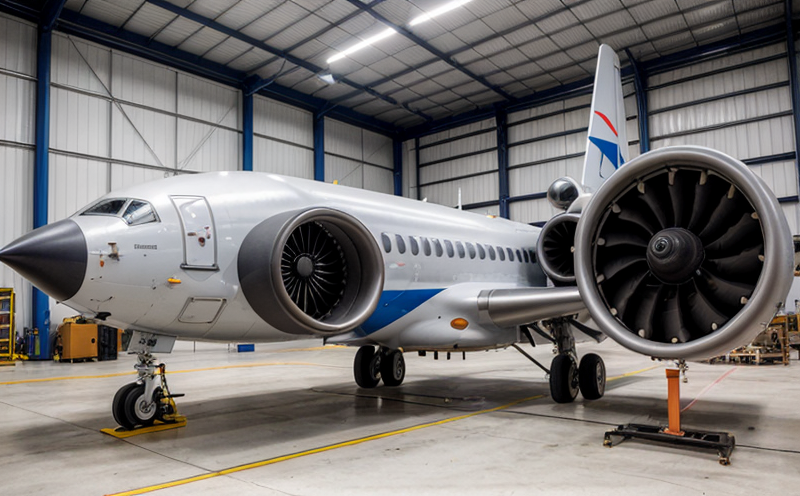Radar Equipment Vibration Testing
In the aerospace and defense sector, radar equipment plays a crucial role in ensuring mission success. The ability of these systems to operate under extreme environmental conditions is paramount for their reliability and performance. Radar vibration testing is an essential process that ensures the robustness of radar equipment against mechanical stresses encountered during flight or operation.
The purpose of this test is to simulate the dynamic loads experienced by radar systems in real-world environments, such as turbulence, landing gear impacts, and other vibrations inherent to air travel. This service involves subjecting radar assemblies to controlled vibration levels that replicate the expected operational environment. By doing so, manufacturers can identify potential weaknesses or design flaws early in the product lifecycle.
The testing process begins with detailed analysis of the equipment's specifications and operational requirements. Using this information, a customized test plan is created to ensure all relevant parameters are accounted for during the vibration simulation. The methodology involves placing the radar unit into a controlled environment where it undergoes prescribed levels of sinusoidal or random vibrations. During testing, engineers monitor key performance indicators (KPIs) such as signal integrity, component stability, and overall structural integrity.
The test results are rigorously analyzed to determine whether the equipment meets predefined acceptance criteria established by international standards like ISO 16750-3 for automotive components or MIL-SPEC standards specific to aerospace applications. Compliance with these standards ensures that radar systems meet stringent industry requirements, thereby enhancing safety and reliability.
It is important to note that proper preparation of the specimen before testing plays a critical role in achieving accurate results. This includes securing the radar unit within the test fixture using appropriate isolation materials to prevent damage from excessive forces transmitted during vibration cycles. Additionally, any external connections or components must be properly secured to avoid loosening or disconnection during testing.
The outcome of successful radar equipment vibration testing provides assurance that the device will function reliably under expected environmental conditions. This not only enhances product quality but also contributes significantly towards meeting regulatory requirements and gaining customer confidence in the reliability of the final product.
Scope and Methodology
| Test Parameters | Description |
|---|---|
| Vibration Frequency Range | Typically covers a range from 10 Hz to 250 Hz depending on the specific application. |
| Vibration Amplitude Levels | Can vary widely based on the type of equipment being tested, but may include peak values up to ±8 g. |
| Test Duration | The duration can range from several hours to multiple days depending on the complexity and criticality of the radar system. |
| Environmental Conditions | Includes temperature ranges, humidity levels, and other climatic factors that might affect performance during vibration testing. |
The process starts with an initial setup where the radar equipment is carefully mounted into a controlled environment. This setup ensures that all components are properly aligned and secured to minimize movement during testing. Once configured, the system begins applying predefined vibration profiles designed to simulate real-world conditions. Throughout this period, continuous monitoring takes place using advanced instrumentation capable of detecting even minor changes in performance metrics.
After completing each cycle, engineers evaluate whether the equipment has met all specified criteria. If any issues arise that do not meet acceptable limits, further adjustments may be necessary before proceeding to subsequent cycles or concluding the test entirely if significant failures occur early on.
Benefits
- Identifies potential weaknesses in design before full-scale production begins.
- Ensures compliance with international standards and regulatory requirements.
- Improves overall product quality by identifying and addressing defects early on.
- Saves time and resources by eliminating costly rework later in the development process.
Radar vibration testing offers significant advantages to manufacturers operating within the aerospace and defense industries. By incorporating this critical step into their quality control protocols, companies can significantly enhance the reliability of their products while reducing risks associated with operational failures. Moreover, successful completion of these tests facilitates easier certification processes by regulatory bodies, ultimately leading to faster market entry.
Why Choose This Test
- The test provides comprehensive evaluation of how radar equipment behaves under various vibration scenarios.
- It helps identify potential areas requiring improvement based on observed behavior during testing.
- By ensuring compliance with relevant standards, it enhances trust among end-users and stakeholders alike.
Selecting radar vibration testing as part of your quality assurance strategy offers numerous advantages. Not only does it provide valuable insights into the performance characteristics of your equipment under simulated conditions, but it also helps build confidence both internally within your organization and externally with customers and partners. Furthermore, meeting stringent industry standards through rigorous testing can open doors to new markets or opportunities for expansion.





